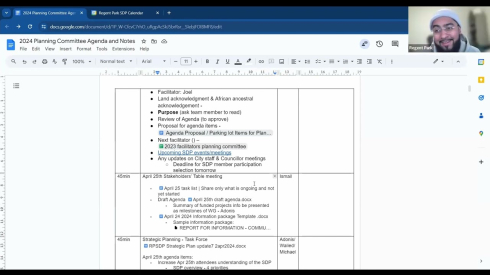- Start playing the video
- Click CC at bottom right
- Click the gear icon to its right
- Click Subtitles/CC
- Click Auto-translate
- Select language you want
Why Rename Dundas Street In Toronto?
By Dimitrije Martinovic
Dimitrije is a staff at FOCUS MEDIA ARTS CENTRE
Dundas Street cuts across an immense swath of neighbourhoods including the community of Regent Park, as it circumnavigates the eastern and western boundaries of Toronto. Beginning in the east end at Kingston Rd. and working its way westward, Dundas Street travels through The Beach, Leslieville, Riverside, Regent Park, Cabbagetown South, ChinaTown, Alexandra Park, Trinity Bellwoods, Little Portugal, Brockton Village, the Junction Triangle, Lambton, Chestnut Hills, Islington, Summerville, Appelwood Heights, Mississauga Valley, and to Erindale at its western edge where it becomes Hwy 5. Each of these neighbourhoods has a distinct cultural vibe and demographic make-up, urban, residential, commercial, suburban and in some case semi-industrial, each locale a mix of rich identities and histories that begs out to be confirmed and celebrated.
So, when Andrew Lochhead, an ally of the Black Lives Matters Movement and a Toronto artist, envisioned the idea of petitioning the City of Toronto to rename Dundas Street, he could not have known that his idea would resonate with so many people, in fact his idea garnered 15,000 signatures in just a short period of time.
The issue with Dundas Street is that it commemorates Henry Dundas, the 1st Viscount of Melville, and a significant political figure in Great Britain during the late 1700s and early 1800s. Among the positions he held during his career are Lord Advocate, President of the Board of Control of the East India Company, Minister of War, Secretary of State for War, and First Lord of the Admiralty. Henry Dundas opposed the abolishment of African slavery and his position as an influential politician is credited for delaying the abolishment of slavery for 15 years during which time it is estimated that approximately 600,000 more Africans passed into slavery. It is also important, despite his name and memory been celebrated in numerous public places across Canada, Henry Dundas never set foot in Canada.
Why name matters? Toponomatics is the study of names, and historically the naming of places has been associated with the founding of that place, for instance -- New Castle, Los Angeles, Novi Grad. Historians may deduce from these names social or cultural aspects that refer to past occupations by different people who have settled in that place including the languages spoken there and other temporally definitive characteristics. Most often what has happened in terms of place names is that with every successive intrusion of new people in a given area, meant that there was some sort of displacement that occurred there – such as a conquest or political over-throw. And so, the naming and renaming of places has always consisted of the notion of “de-commemoration” on the one hand, while on the other hand it celebrated a new “commemoration” that supplanted the previous event/person/place.
Among Indigenous peoples, place names for example serve as mnemonic devices, conveying information and knowledge about the land that combines both the spiritual and environmental characteristics of a place. Place names may contain ‘ways of being’, reminding travelers of seasonal resources or they may recall moral teachings. The Aboriginal people of Australia have a belief system known as “songline” or “dream track” according to which a person may travel safely across the land by following a path once traveled by sacred ancestors (handed down through song and ritual), the “songline” would have information about landmarks, waterholes, and other critical survival features.
With the colonization of the Americas, Africa, Asia, and Australia by Europeans, the traditional associations with place names were lost. In Canada, this has meant that most places have names rooted in French and English cultures and histories – past monarchs, religious saints, famous personages, and memorable places in Europe.
Fortunately, there are numerous initiatives across Canada dedicated to restoring the long history of Indigenous place names, like the Ogimaa Mikana Project that seeks to restore Anishinaabemowin place-names to the streets, avenues, roads, paths, and trails of Gichi Kiiwenging (Toronto).
The project of colonizing the new world brought with it another feature that from its earliest beginnings, due to the development of plantation estates and the lack of an indentured work force large enough to do the work, the implementation of slaves becomes the method by which large-scale resource extraction begins to fund the Colonial Empires of Portugal, Spain, France, Holland, and Great Britain. Much has been written on the subject of slavery and the impact of Europeans on Africans, but there is some fundamental knowledge that needs to be addressed regarding the psychology of slavery. Torrance T. Stephens a professor at Clark Atlanta University, Department of Psychology, had this say on the subject:
“Since the main reason for slavery was an economic one, it was essential for Europeans to develop a rationale in support of slavery, which resulted in an attached stigma to African people in the colonies. The logic was based on the view that Africans were sav age and not human and that it was the duty of whites to make Africans worthwhile. Thus, the legal discrimination of African preceded and led to a status of physical and psychological inferiority being attached to slaves in the American South. This attitude may have best been evinced in the disposition of the people involved with slavery at all levels.”
These racial attitudes which were the by-product of slavery from then on become entrenched in the institutional fabric of the United States. It is same these attitudes of racial superiority that are mirrored in the treatment of Native Peoples, allowing Europeans to omit and cast aside the history of both Africans and Indigenous populations – privileging the ensuing years as a Whites only history.
Fortunately, there are numerous initiatives across Canada dedicated to restoring the long history of Indigenous place names, like the Ogimaa Mikana Project that seeks to restore Anishinaabemowin place-names to the streets, avenues, roads, paths, and trails of Gichi Kiiwenging (Toronto). Andrew Lochhead’s petition has also garnered the support of Toronto City Council and as a result, the City has initiated a review of its policies related to renaming and a public consultation process.
It is not that the renaming of streets, avenues, roads, paths, and trails means that suddenly the one historical record will be rendered more important than another, but rather, it will mean that the history that has been omitted will have an equal place, one also worthy of commemoration.
Here in Regent Park, we might take a page of from Andrew and these discussions of naming and renaming public spaces, and along with Dundas Street, reconsider renaming Regent Park. Why should the area bear the name of a dead English monarch, why note instead give it a name that truly evokes the history of its past, present and future?
Reference: Psychology Of Slavery, Torrance T Stephens.
Add new comment
FOCUS Media Arts Centre (FOCUS) is a not-for-profit organization that was established in 1990 to counter negative media stereotypes of low income communities and provide relevant information to residents living in the Regent Park area and surrounding communities.
We seek to empower marginalized individuals and under represented communities to have a voice, through the use of professional training, mentorships and participatory based media practices that enable the sharing of stories, experiences and perspectives on relevant matters and issues. In brief our mandate is to empower marginalized individuals and under-serviced communities to have a voice and tell their own stories.











We encourage comments which further the dialogue about the stories we post. Comments will be moderated and posted if they follow these guidelines:
The Community Media Portal reserves the right to reject any comments which do not adhere to these minimum standards.